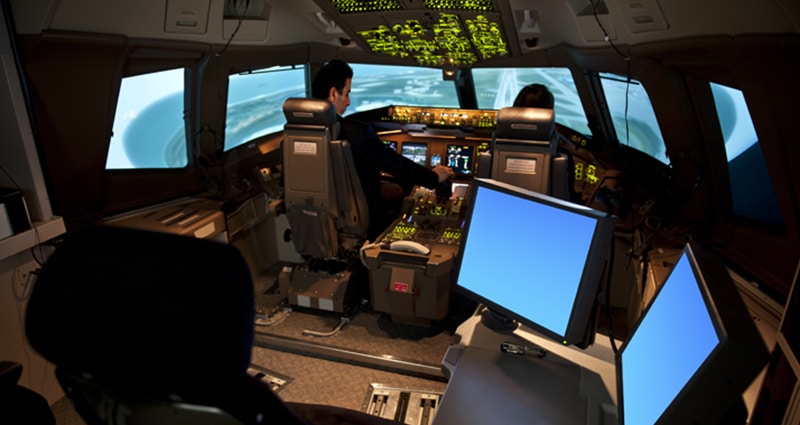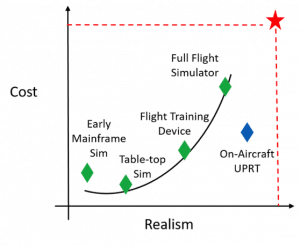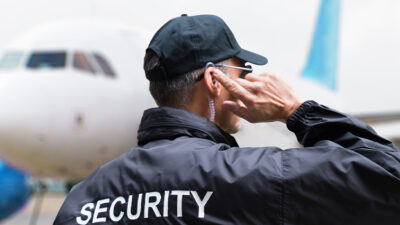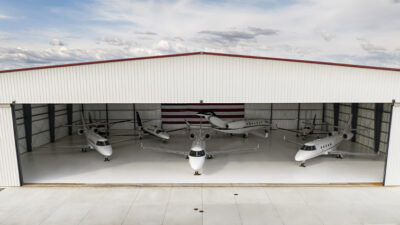What is the Real Cost of Realism in Training?

The ongoing debate over the merits of training on-aircraft or in a flight simulator continues. Flight simulation has reached extraordinary levels of fidelity, and the typical costs and risks of training in ‘the real thing’ continue to influence the market towards simulator training. But what are the real costs of advanced simulator training? What if we could also train in a cost-effective, low-risk equivalent of the ‘the real thing’?
Cost analysis of training simulation over the last 20 years is complex. Initially high costs of mainframe computing power in the 1960s gave way to much cheaper desktop computers in the 70s and 80s. But as the cost per calculation plummeted, the sophistication of programming increased exponentially. This led to ever-increasing realism in the simulations, but at a dramatically higher cost than your desktop PC!
The following chart shows a rough price comparison of various flight simulators—there is no mystery here; the increasing costs are directly proportional to the increased realism provided in the simulation:1, 2
| Microsoft Flight Simulator X | less than $100 |
| Table-mounted, single-screen with yoke and rudder pedals | $1,000-$5,000 |
| Redbird G1000 trainer | less than $10,000 |
| Redbird FMX full-motion, enclosed trainer | less than $100,000 |
| FAA Qualified Level 6&7 Flight Training Devices (no motion) | less than $1,000,000 |
| FAA Qualified Full Flight Simulators (full motion) | $10,000,000-$50,000,000 |
At the high end the training device can cost as much as, or more than, the real platform! Additionally, expensive maintenance and upgrade costs on the higher end devices are required to keep the fidelity of the training on pace with the upgrades to the real platform.3 However, despite very high initial costs, student throughput can typically amortize the capital investment in under 10 years, making them very cost effective in the long term.4
If we create a notional graph of simulator realism vs. cost it might look like the figure below. We have been taught to think along this curve; either we pay for (and risk) training in the real platform, or we settle for a simulation, and are forced to balance cost with realism in that decision.

But what if we thought outside this curve? To our original question, what if we could find a low-cost, low-risk training alternative to the ‘the real thing’? This is not a new concept—Naval Aviators practice parachute procedures by para-sailing, not by jumping out of airplanes. Diving students practice in the deep end of a swimming pool for weeks before they hit the open water.
Upset Prevention and Recovery Training (UPRT) is a prime candidate for this ‘off the curve’ approach. Doing such training in your main aircraft is likely both too risky and cost prohibitive, but the primary learning points of UPRT are best taught on-aircraft. The result is a growing vendor base providing on-aircraft UPRT in safe, inexpensive, all-attitude aircraft. The student receives some of the best training of their aviation careers in a stable, cost-effective environment.
There is no doubt that high-fidelity simulators are fantastic training tools, and UPRT procedures learned on-aircraft should certainly be duplicated and practiced in the safety of your main aircraft simulator. However, the premise that simulators are cheaper than ‘the real thing’ is flawed, and will cause us to miss out on opportunities to experience on-aircraft training that is truly real, at a cost point that may be far less than high fidelity simulators.
Resources
1 Redbird Flight Simulations, May 27, 2010, http://www.flyingmag.com/safety/training/redbird-flight-simulations
2 How Much Does it Cost to Buy a Flight Simulator?, March 15, 2015, https://www.quora.com/How-much-does-it-cost-to-buy-a-flight-simulator
3 Flight Simulator Training: Cutting Costs and Improving Skills, December 8, 2015, http://upperlimitaviation.edu/flight-simulator-training-cutting-costs-and-improving-skills/
4 Why Use Simulation? – Return on Investment, National Training and Simulation Association (NTSA), http://www.trainingsystems.org/publications/simulation/roi_effici.cfm

Prevailance Aerospace is a UPRT provider that has been working with corporate, government, and general aviation pilots to improve safety in the aviation industry. Prevailance Aerospace uses Extra 300 Series Aircraft for training and our pilots are experienced aviation professionals from various military and general aviation backgrounds. We know that successful aviation endeavors are accomplished through an uncompromising commitment to safety, impeccable professionalism, tremendous attention to detail, and constant improvement.
http://www.prevailance.com
© 2025 Prevailance Aerospace. All Rights Reserved.
Next ArticleRelated Posts

Emerging Security Threats in Business Aviation: Activism and Down-Route Risks
Security incidents affecting business aviation do not need to involve violence to have an operational impact. A protest delaying crew movements, blocking access to a hangar or resulting in an unauthorized photograph of a sensitive client can all trigger reputational, financial or compliance concerns for operators.

Navigating Geopolitical Uncertainty Using Business Aviation
Bigger business jets mean bigger fuel tanks, longer trips, more border crossings, and bigger wallets! With an equipment upgrade also comes the requirement for a knowledge upgrade.

